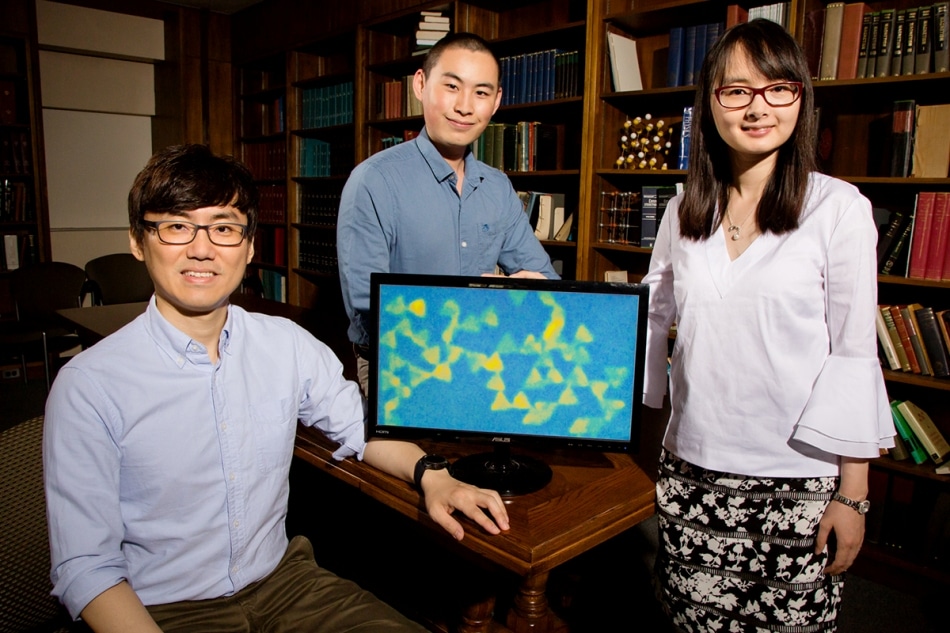Oct 3 2017
In the case of nanoparticle self-assembly, seeing is believing. Engineers from the University of Illinois are studying the interactions of colloidal gold nanoparticles within miniature aquarium-like sample containers to achieve further control over the self-assembly process of engineered materials.
 University of Illinois postdoctoral researcher Juyeong Kim, left, graduate student Zihao Ou and professor Qian Chen have developed a new technique for observing colloidal nanoparticles while they interact and self-assemble. (Photo by L. Brian Stauffer)
University of Illinois postdoctoral researcher Juyeong Kim, left, graduate student Zihao Ou and professor Qian Chen have developed a new technique for observing colloidal nanoparticles while they interact and self-assemble. (Photo by L. Brian Stauffer)
Self-assembling colloidal nanoparticles are one of the things that make solar cells, LED displays and batteries function. Researchers examine these nanoparticles with still images using high-powered electron microscopes, but since colloidal nanoparticles interact via motions in liquids, traditional electron microscopy-based observation techniques cannot trap the interactions that occur when these nanoparticles self-assemble, said Qian Chen, a Professor of Materials Science and Engineering and Co-author of a new research paper.
The colloid self-assembly process has always been a bit of a black box. The particles behave like atoms and molecules, which allows us to use classical chemistry and physics theories to model their behavior. This new method, called liquid-phase transmission electron microscopy, allows us to see exactly what is happening.
Qian Chen, Professor of Materials Science and Engineering and Co-author of a new research paper
The team’s new technique, published in Nature Communications, also demonstrates that the shape of nanoparticles can manipulate the types of materials created.
“One challenge in nanotechnology is conquering our inability to control the process of artificial assembly,” Chen said. “By working with particles of different shapes, we can control how the particles stack up together, almost like playing with tiny Legos toys. This type of control will make a difference in a material’s properties and application.”
We can follow the trajectory of the nanoparticles, precisely and continuously, which gives us the power to map out the assembly rate laws quantitatively. Particular shapes prefer to attach in a way similar to how molecules connect into big polymers, and we can reproduce those conditions, which is a huge step forward in the fundamental understanding and the control over nanoparticle self-assembly.
Juyeong Kim, Postdoctoral Researcher and Lead Author
The team chose to investigate using gold for a reason.
“Gold shows excellent contrast under TEM because it is a heavy element, making it easy to observe,” said Graduate Student and Co-author Zihao Ou. “It is also a very stable and generally nontoxic element, which is beneficial for applications within the human body, like medicine.”
Colloidal gold contains a property that allows it to concentrate electromagnetic radiation, like light waves, allowing it to generate heat. One possible application of this is something called photothermal therapy, where we can inject colloidal gold into a patient to target cancer cells and destroy them with heat.
Juyeong Kim, Postdoctoral Researcher and Lead Author
Chen also foresees the liquid-phase TEM technique being used to examine the structure of microorganisms and proteins within the human body. Proteins have to be crystallized or frozen for analysis, which is not suitable. Her team is currently exploring proteins in liquid environments using liquid-phase TEM to see how they self-assemble and alter their shape.
This study was supported The U.S. Department of Energy, Office of Basic Energy Sciences – Division of Materials Sciences and Engineering through the Frederick Seitz Materials Research Laboratory at the U. of I.